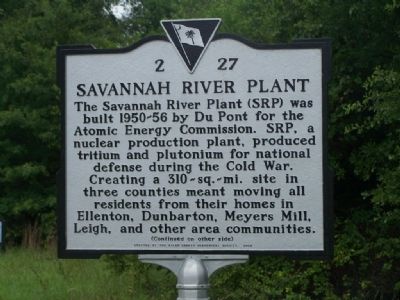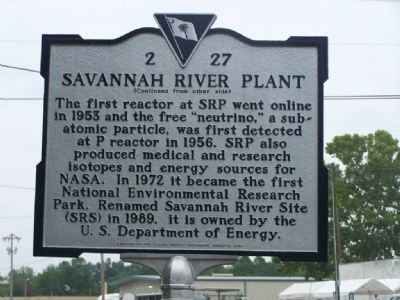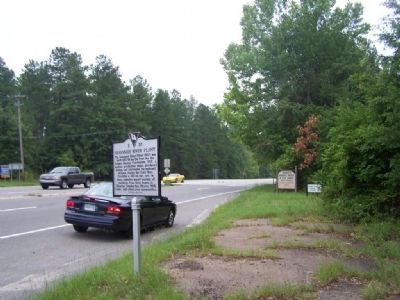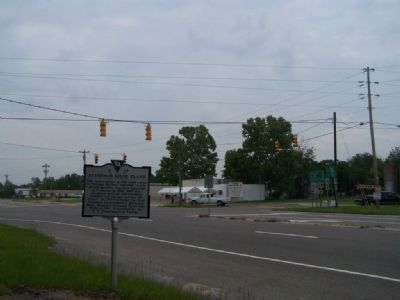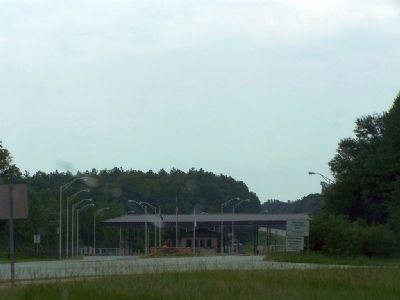New Ellenton in Aiken County, South Carolina — The American South (South Atlantic)
Savannah River Plant
The Savannah River Plant (SRP) was built 1950–56 by Du Pont for the Atomic Energy Commission. SRP, a nuclear production plant, produced tritium and plutonium for national defense during the Cold War. Creating a 310-sq.-mi. site in three counties meant moving all residents from their homes in Ellenton, Dunbarton, Meyers Mill, Leigh, and other area communities.
(Reverse text)
The first reactor at SRP went online in 1953 and the free “neutrino,” a subatomic particle, was first detected at P reactor in 1956. SRP also produced medical and research isotopes and energy sources for NASA. In 1972 it became the first National Environmental Research Park. Renamed Savannah River Site (SRS) in 1989, it is owned by the U.S. Department of Energy.
Erected 2004 by Aiken County Historical Society. (Marker Number 2-27.)
Topics. This historical marker is listed in these topic lists: Charity & Public Work • Industry & Commerce • War, Cold • Waterways & Vessels. A significant historical year for this entry is 1953.
Location. 33° 23.497′ N, 81° 41.077′ W. Marker is in New Ellenton, South Carolina, in Aiken County. Marker is on South Main Street (State Highway 19) near Williston Road (U.S. 278), on the right when traveling east. Touch for map. Marker is in this post office area: New Ellenton SC 29809, United States of America. Touch for directions.
Other nearby markers. At least 10 other markers are within 12 miles of this marker, measured as the crow flies. Millbrook Baptist Church (approx. 9.4 miles away); Pascalis Plantation / Pascalina (approx. 10 miles away); Downer Institute & School / Downer School, 1924–1986 (approx. 10.4 miles away); William Bartram Trail (approx. 10.4 miles away); Historic Church (approx. 10˝ miles away); Redcliffe Plantation (approx. 10.6 miles away); Aiken Training Track (approx. 10.8 miles away); Beech Island Baptist Church (approx. 11 miles away); Coker Spring (approx. 11.3 miles away); Gaston Livery Stable (approx. 11.3 miles away).
Regarding Savannah River Plant. When the Cold War began in the 1950s, the nation called on Aiken, Barnwell and Allendale counties to provide about 200,000 acres of farmland and forest. Nearly 1,500 families were displaced in the name of freedom and protection from Soviet Communism.
The federal government put more than 38,000 people to work by September 1952, toiling around the clock toward
the production of plutonium and uranium needed for hydrogen and atomic bombs.
Environmental contamination and worker safety issues at the plant were the subject of Building Bombs, a 1991 documentary film by Mark Mori and Susan Robinson.
Related markers. Click here for a list of markers that are related to this marker. To better understand the relationship, see each marker shown.
Also see . . .
1. Savannah River Site ( includes pictures). The site is located near Aiken, South Carolina, and encompasses over 300 square miles. There are more than 1,000 facilities at the site concentrated in only 10 percent of the total land area. The Savannah River Operations Office is responsible for oversight of the operations at SRS. (Submitted on August 4, 2008, by Mike Stroud of Bluffton, South Carolina.)
2. Savannah River Plant. The site was built during the 1950s to refine nuclear materials for deployment in nuclear weapons. (Submitted on August 4, 2008, by Mike Stroud of Bluffton, South Carolina.)
3. United States Atomic Energy Commission. The United States Atomic Energy Commission (AEC) was an agency of the United States government established after World War II by Congress to foster and control the peace time development of atomic science and technology. (Submitted on March 16, 2009, by Brian Scott of Anderson, South Carolina.)
4. Ellenton, South Carolina. Ellenton, South Carolina was a town in Aiken County. (Submitted on March 16, 2009, by Brian Scott of Anderson, South Carolina.)
5. Dunbarton, South Carolina. Dunbarton, South Carolina was a town in Barnwell County, South Carolina. (Submitted on March 16, 2009, by Brian Scott of Anderson, South Carolina.)
6. Meyers Mill, South Carolina. Meyers Mill, South Carolina was an unincorporated community in Barnwell County, South Carolina, United States. (Submitted on March 16, 2009, by Brian Scott of Anderson, South Carolina.)
7. Savannah River Site: Savannah River Remediation. Historic Tank Marker Donated to Savannah River Site Archives AIKEN, S.C. (February 6, 2013) – The 1997 marker commemorating the operational closure of the nation’s first Cold War era nuclear waste tank has been donated by Savannah River Remediation (SRR) to the Savannah River Cold War Artifact Collection (Submitted on February 15, 2013, by Mike Stroud of Bluffton, South Carolina.)
Additional commentary.
1. New Historical Marker
Aiken Standard
8/27/10
A crowd of more than 50 people gathered in front of the Greater Aiken Chamber of Commerce Friday morning to commemorate scientific history made in Aiken 54 years ago.
Members of local government, county residents and Savannah River Site employees and their families kicked off the all-day celebration of the discovery of the neutrino, an elementary particle with no charge and nearly no mass
first detected at SRS.
The discovery, made by a team led by Clyde Cowan and Frederick Reines, earned the only Nobel Prize for physics ever awarded in the state of South Carolina to date.
"Neutrinos are the closest thing to nothing that's still something," SRS Heritage Foundation Executive Director Walt Joseph said last week, a sentiment that was also printed on T-shirts worn by several members of the audience."If the neutrino had never been detected, the conservation of energy would have always been in doubt," Joseph said Friday.
The discovery of the neutrino came about when scientists were unable to account for a small amount of energy in their calculational models that they could not detect. Through the use of P Reactor at SRS, Cowan and Reines were able to detect the particle, which can pass through matter almost undisturbed.
The importance of the discovery did not stop at its detection, Joseph said, but allowed scientists to apply the new knowledge to calculations related to the Big Bang, also known as the "Birth of the Universe."
The ceremony's speakers, including County Council chairman Ronnie Young, praised the members of the audience - many of whom wore shirts with SRS emblems embroidered on them - for their contributions to an important piece of local history.
"Those who come after us will understand the heritage of the site," Young said.
Among the crowd on Friday morning were Marian Cowan Kriston and Elizabeth Cowan Riordon, daughters of the late Clyde Cowan, who returned to Aiken this week from Maryland and Ohio, respectively.
"The family is so excited, and we have such memories of Aiken. It is so wonderful that they've kept the history," said Marian, who was just over 1 year old at the time of the discovery. "It is so exciting what they're doing because the newcomers don't know the history."
Elizabeth, who was 11 years old when her father detected the neutrino at SRS, recalls the partnership between her father and Reines.
"Fred kept the math going, and Daddy - he liked the math, but he kept the equipment going," she said.
The historical marker, which now stands directly in front of the chamber building at 121 Richland Ave., was also unveiled during the ceremony. The plaque, a replica of the original plaque awarded by the U.S. Atomic Energy Commission which is now at the University of California-Irvine, was also officially unveiled at the ceremony.The celebration continued Friday afternoon with informative presentations at USCA's Etherredge Center. The crowd watched a video of the late Cowan discussing the experiments and research that led to the neutrino's detection, as well as presentations about neutrinos in particle astrophysics and neutrino research in using accelerators.
The evening concluded
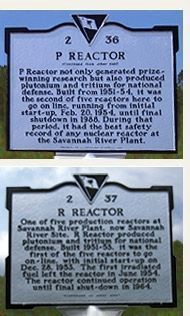
Photographed By SRS History Highlights
6. Savannah River Plant Marker
• Historical markers were placed in P and R Areas commemorating the role played by P- and R-Reactor towards winning the Cold War. The site’s first two nuclear production reactors, R-Reactor began operations in 1953, P-Reactor in 1954.
2-36 Reads:
P Reactor
P Reactor not only generated prize- winning reach but also produced plutonium and tritium for national defense. Built from 1951 - 1954, it was the of five reactors here to go on line, running from initial start - up, Feb. 20, 1954, until final shutdown in 1988. During that period, it had the best safety record of any nuclear reactor at Savannah River Plant.
2-37 Reads:
R Reactor
One of five production reactors at Savannah River Plant, now Savannah River Site, R Reactor produced plutonium and tritium for national defense. Built in 1951 - 1953, it was the first of five reactors to go on-line with initial start-up on Dec. 28, 1953. The first irradiated fuel left the reactor in June 1954. The reactor continued operation until final shut-down in 1964.
2-36 Reads:
P Reactor
P Reactor not only generated prize- winning reach but also produced plutonium and tritium for national defense. Built from 1951 - 1954, it was the of five reactors here to go on line, running from initial start - up, Feb. 20, 1954, until final shutdown in 1988. During that period, it had the best safety record of any nuclear reactor at Savannah River Plant.
2-37 Reads:
R Reactor
One of five production reactors at Savannah River Plant, now Savannah River Site, R Reactor produced plutonium and tritium for national defense. Built in 1951 - 1953, it was the first of five reactors to go on-line with initial start-up on Dec. 28, 1953. The first irradiated fuel left the reactor in June 1954. The reactor continued operation until final shut-down in 1964.
The event was part of Aiken's 175th anniversary celebration.
— Submitted January 12, 2011, by Mike Stroud of Bluffton, South Carolina.
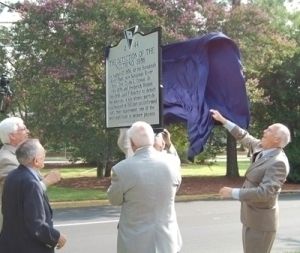
By Anna Doliaitis, Staff writer, Aiken Standard
7. Savannah River Site Marker New Marker 2-44
*** Marker Reads... ***
The Detection of the Neutrino, 1956
On August 27, 1956, at the Savannah River Plant (now Savannah River Site), Drs. Clyde L. Cowan, Jr. (1919-1974) and Frederick Reines (1918-1999) used P Reactor to detect the neutrino, a sub-atomic particle hypothesized in 1930 but unconfirmed until their experiment, one of the most significant in modern physics.
The Nobel Prize, 1995
In 1995 Dr. Frederick Reines was awarded the Nobel Prize in Physics for his and Dr. Clyde L. Cowan’s detection of the neutrino at the Savannah River Plant. The Nobel citation called their experiment “a pioneering contribution that opened the doors to the region of ‘impossible’ neutrino experiments.”
2-44 Erected by the Savannah River Site Heritage Foundation, 2010
Click for more information.
The Detection of the Neutrino, 1956
On August 27, 1956, at the Savannah River Plant (now Savannah River Site), Drs. Clyde L. Cowan, Jr. (1919-1974) and Frederick Reines (1918-1999) used P Reactor to detect the neutrino, a sub-atomic particle hypothesized in 1930 but unconfirmed until their experiment, one of the most significant in modern physics.
The Nobel Prize, 1995
In 1995 Dr. Frederick Reines was awarded the Nobel Prize in Physics for his and Dr. Clyde L. Cowan’s detection of the neutrino at the Savannah River Plant. The Nobel citation called their experiment “a pioneering contribution that opened the doors to the region of ‘impossible’ neutrino experiments.”
2-44 Erected by the Savannah River Site Heritage Foundation, 2010
Click for more information.
Credits. This page was last revised on April 18, 2021. It was originally submitted on August 4, 2008, by Mike Stroud of Bluffton, South Carolina. This page has been viewed 3,412 times since then and 51 times this year. Photos: 1, 2, 3, 4, 5. submitted on August 4, 2008, by Mike Stroud of Bluffton, South Carolina. 6. submitted on January 19, 2009, by Mike Stroud of Bluffton, South Carolina. 7. submitted on January 10, 2011, by Mike Stroud of Bluffton, South Carolina. • Craig Swain was the editor who published this page.
